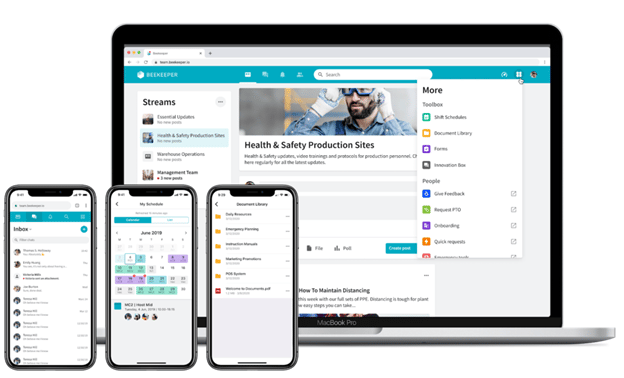People Analytics│Data-Driven Decisions for a More Productive Workplace

Ever heard the saying, “what gets measured, gets managed?” Businesses across industries, sizes, and operational complexities are adopting this mantra – and their new secret sauce, people analytics – to improve their workplaces.
Gone are the days of making workplace decisions without the data to back it up. In fact, with the right tools, you could have more data than you know what to do with.
In HR, people analytics data is becoming critical for improving processes that attract, retain, and develop diverse and dispersed workforces.
But, what is people analytics? We’ll find out!
Let’s take a look at all things people analytics to help your business evolve with its growing workforce.
What Is People Analytics?
First up: What is people analytics?
According to Gartner,
“People analytics is the collection and application of talent data to improve critical talent and business outcomes. People analytics leaders enable HR leaders to develop data-driven insights to inform talent decisions, improve workforce processes and promote positive employee experience.”
At the heart of it, people analytics looks at specific attribute data to improve decision-making within the company. That data can include:
- Job role
- Age
- Gender
- Race
- Pay
- Absenteeism
- Turnover
- Hiring expenses
- Employee engagement survey
A recent Deloitte survey says business approaches to people analytics have evolved over time. And that only 9% of companies feel they understand the talent factors that influence employee performance.
“Formerly a technical discipline owned by data specialists, people analytics is now a business discipline, supporting everything from operations and management to talent acquisition and financial performance.”
The Difference Between Employee, People, and Workforce Analytics
You may have already heard of employee analytics. But, people analytics is different – and so is workplace analytics.
As we see it, people analytics gets into the details of HR-related practices. And, people analytics are critical for fine-tuning the return on investment for each employee. We’ll get into specific people analytics metrics in a bit.
Workplace analytics extend beyond retention metrics to analyze employee productivity, effectiveness, and engagement.
Examples of measuring workplace analytics include:
- Total collaboration hours
- Engagement with company communications
- Participation in employee pulse surveys employee
And, employee analytics covers all these critical aspects to provide a real-time snapshot of the organization’s employee experience.
Why Is It Important To Track People Analytics?
Now, the important question, why do people analytics matter?
Using people analytics aims to help the business best understand its employee landscape to achieve company objectives quicker.
Want to know your workforce demographics? Or, what motivates employees to perform at their best? Or, what business unit experiences the highest rate of absenteeism?
Ultimately, leveraging people analytics data the right way improves employee, operational, and overall business performance.
Businesses that use people analytics to make better decisions report 82% higher three-year average profit than peers.
Outside of turning a profit, there are plenty of other benefits to adopting and analyzing people analytics, such as:
- Improved decision-making in the organization
- Achieved fair pay
- Increased diversity
- Elevated productivity
- Reduced employee turnover
- Aligned goals and objectives
- Better hiring practices (and recruiting!)
- Lower operational costs
- More opportunity for transparent feedback
- Improved business returns
The opportunities are endless when businesses leverage data to improve the workplace experience.
Examples Of People Analytics Metrics

If you’re anything like us, you want to know specific metrics to track people analytics. You’ve come to the right place!
Here are some of the top people analytics metrics you can start tracking today.
Total Time To Hire
The total time to hire metric captures the time it takes from the moment a candidate applies to when they accept an employment offer. With time to hire metrics, your company can gauge how quickly you act when finding the best candidate for an open role.
If your total time to hire average is too high, it could mean you’re turning talent away because your hiring process takes too long.
Pro tip: It’s important to note that time to hire can get confused with time to fill. Whereas time to hire tracks the time it takes to hire a candidate, time to fill traces the time it takes HR to fill a role.
Early Turnover
Want to know if your company has a solid track record for hiring the right people? Or, if your high hiring expenses are worth it because employees are staying? Take a look at your average early turnover.
To capture early turnover, you review the number of new hires that left within their first year. This can get even easier if you track by new hire cohorts.
Revenue Per Employee

The revenue per employee metric is essential in capturing the average employee’s productivity and efficiency rate. The metric takes the business’s total revenue and divides it by the current number of employees.
Cost Per Hire

The cost per hire metric is a primary metric that tracks the average expense a company takes on with each new hire. The metric adds the internal and external recruiting costs and divides them by the total number of hires within a given period.
Pro tip: Tracking this metric comes in handy when it’s time to review your annual recruiting budget.
Absenteeism

Absence in the workplace is unavoidable. People get sick and need time to get better. Or they need to handle personal matters during work hours.
But, sometimes, high absenteeism can indicate more significant workplace issues. To trace absenteeism, you take an employee’s total number of absent days and divide that by the number of available working days.
6 Actionable Ways to Leverage People Analytics In The Workplace
Knowing what to measure is a critical first step in making data-driven improvements in the workplace. Now, we need to apply it.
Here are six ways to use people analytics in your workplace.
Hiring and Recruiting Challenges
With people analytics data, companies can tackle everyday business challenges with a more informed approach.
For example, hiring and recruiting are essential parts of any business. To make these processes more effective, HR leaders need an objective lens into factors like:
- Cost of hiring
- Cost of turnover
- Cost of training
- Turnover rates
- Time it takes to make a new hire
- Rationale for leaving
Turnover Issues
In today’s competitive talent environment, every new hire counts. And, every lost employee comes at a high price. According to Work Institute, voluntary turnover costs more than a staggering $630 billion.
Employee turnover has other non-financial consequences, such as:
- Low employee morale
- Negative business performance
- Damaged reputation
- Toxic workplace culture
If your organization has a higher turnover rate than average, it’s likely time to reflect internally. One way to integrate improvements that stick is by going directly to the source – your employees.
Diversity and Inclusion
Employees are any business’s greatest asset. And, for companies that want to thrive, workforce diversity should be promoted, celebrated, and proactively improved.
People analytics provides an unaltered view into a company’s current landscape by highlighting:
- Diversity gaps
- Unequal compensation structures
- Diversity retention challenges
- Recruitment blind spots
In better understanding where the organization is today, it can quickly move to create a better tomorrow – for every employee.
Performance Management
Employee workplace performance is essential for doing good business. However, when employee performance is struggling, it’s necessary to understand why before making any changes.
With people analytics, businesses can find out where employees are falling behind. Are they overloaded? Or, are they just not interested?
One helpful way to measure employee productivity is through regular performance reviews. In these 1:1 sessions with managers, employees can unload any frustrations, roadblocks, or disengagement factors impacting their drive to do their best work.
Not convinced employee performance reviews matter? Gallup found companies that provide employees with regular employee reviews had 15% lower turnover rates.
Learning and Development
Outside of employee performance, people analytics can also influence better decision-making when it comes to workplace development. And development can impact retention.
40% of employees leave their positions within their first year if they don’t receive proper job training.
Professional learning and development programs can impact a number of workplace issues, such as:
- Skill and knowledge gaps
- Employee loyalty
- Performance issues
- Employee engagement
Yet, if your program isn’t up to snuff, you may want to re-think your approach. Some ways you can improve learning and development in your organization are:
- Use data to know what courses employee enjoy most or least
- Identify areas of training that employees get stuck at frequently
- Offer digital training materials for frontline employees that are usually on the go
You can also reach out directly to employees to find out what they would like to see in terms of learning and development opportunities.
Employee Engagement
By tracking people analytics, company leadership teams are better equipped to engage their workforces like never before. And that leads to better business outcomes.
According to a study by the University of Pennsylvania’s Wharton School, companies with higher employee engagement exceed financial performance than peers by 74%. Why? Because engaged workers are 44% more productive.
However, spurring employee engagement is a lot easier said than done. Here are our top tips to increase employee engagement in your workplace:
- Take employee engagement surveys seriously. Companies that genuinely want to improve employee satisfaction will ask for transparent feedback. And, they’ll act on it.
- Remember, employee engagement impacts everyone. From customers to shareholders to executive leadership teams, everyone benefits from a highly engaged workplace.
- Untap potential by inspiring employees at all levels. People want to work where they feel valued, challenged, and recognized. For employee groups that often go unnoticed, like frontline workers, that could mean something as simple as communicating through a channel built for them.
- Champion it at the top. Employees want to feel invested in, even at the highest levels of the business. Get your CEO on board to show your workers how important employee engagement is to your business.
How To Get Started Tracking People Analytics

Now, you know what to measure and how to apply it. Next up: getting started.
Tracking people analytics doesn’t have to be an overwhelming process.
Here’s our 5-step process to get you started.
1. Define Your Strategy
Before taking any steps in tracking people analytics in your organization, it’s crucial to outline your why. Start by considering these questions:
- Is your company ready to track people analytics?
- Are you trying to reduce turnover?
- Would you like to create a better hiring experience?
- Do you need to address diversity gaps?
- Are there skills you’d like the workforce to adopt?
These aren’t all of the questions you should consider. But they will get you off to a running start. Developing a solid strategy and purpose for tracing employee analytics is the core of building a better workplace.
2. Set Achievable Goals
With a strategy in hand, it’s time to set your goals. And, make sure they’re SMART goals:
- Specific
- Measurable
- Achievable
- Relevant
- Time-bound
For instance, you may want to reduce the time to hire by 10% within 12-months. To do that, you need to review every step of the hiring process and identify, address, and improve bottleneck areas.
Ultimately, when you look back a year from now, you want to make sure you’ve identified the right goals that will help you achieve your mission.
3. Know What to Track
We’ve provided some of the most common people analytics metrics to help you get going. But, it’s crucial to map out which metrics are most impactful to your business and your goals.
If you’re aiming to reduce new hire turnover, you may want to track your hiring time. Or, if you’d like to improve overall turnover rates, you may want to trace employee engagement levels.
4. Adopt the Right Tools
Once you have your tracking metrics, how do you plan to capture them?
The most important step for tracking people analytics is using the right software and tools to capture the information you need to make informed decisions. More on this in a bit!
5. Ask for Feedback
When you look at the applications for people analytics, there is one glaring commonality – employee feedback. When it comes to workplace improvement, there aren’t many things that trump direct and transparent feedback from the employees themselves.
People analytics will put a data-oriented spin on your current landscape that will help drive improvements. And, once you have the data you need, incorporate the employees themselves on where, how, and why you can do better.
4 Tips for Selecting Your People Analytics Software

Tracing people analytics can be a cumbersome task without the right tools. Enter: people analytics software.
Here are our top tips for selecting your people analytics software:
1. Make It Flexible
Today, workforces are more dispersed than ever. So, in order to implement software to track people analytics, you need to make sure it’s as flexible as you need it to be.
For frontline-majority businesses, mobile is best. At Beekeeper, we know a thing or two about reaching essential employees on the go.
For instance, we know regardless of if you are on the front line or in the boardroom, you may need access to people analytics data in real-time. That means you need a flexible tool that can be accessed no matter where you are.
2. Ensure You Have Access to a Comprehensive Dashboard
When it comes to tracking people analytics, you want to see results fast. That means you need a reporting dashboard to capture rich data quickly.
With Beekeeper’s Analytics Dashboard, you can securely and accurately capture:
- Total number of active users on the platform
- Employee survey responses
- User engagement and app behavior
- Percentages of employees that opened a communication
- Rates of employees that have read a company message
3. Prioritize Data Security
Employee information and data security should be a top priority at all times. Particularly as cybersecurity breaches are on the rise.
No matter which people analytics software option you go with, you should ensure it comes with best-in-class security measures, such as:
- Advanced firewall protection
- Full data encryption
- Regular security audits
- Regulatory compliance, including GDPR and ISO 27001 certification
4. Choose a Technology Solution that Meets Your Needs
Finally, the most important thing you can do is select a software provider that is the best fit for your company, goals, and employee base.
We often see customers making a switch because their previous partner didn’t capture what they needed. Or didn’t reach the employees that are most impactful to their business. Or didn’t provide the right level of customer support.
When considering different tools, remember to go back to the beginning. Reference your strategy, goals, and desired metrics, and ensure the tool you select will help you deliver on each and every one.
Check out our white paper for more data-driven HR trends!

About the author
Beekeeper
We make frontline lives easier, work safer, and teams more connected so businesses can reach new heights. At Beekeeper, we’re dedicated to making frontline lives easier by connecting workers with the tools, support, and information they need to feel valued, do their best work, and drive the business forward.
Interested in learning more?
Join 1200+ companies transforming frontline work with Beekeeper. Start your journey today to make every task easier, every team stronger, and every shift smoother.







